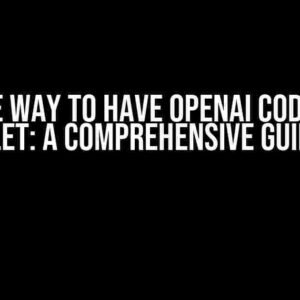Are you tired of wrestling with Python’s default attribute behavior? Do you find yourself stuck in a world of confusion when it comes to static default attributes and the `post_init` method? Fear not, dear Python enthusiast, for today we’re going to dive deep into the world of Python’s post_init and explore how to harness its power with changed static default attributes.
What is post_init and why do we need it?
Before we dive into the nitty-gritty, let’s take a step back and understand what `post_init` is and why it’s a game-changer. `post_init` is a special method in Python that is called after an object has been initialized. It’s a hook that allows you to perform additional setup or configuration after the object’s `__init__` method has finished executing.
So, why do we need `post_init`? Well, imagine you have a class with a bunch of default attributes that you want to initialize with specific values. You can use the `__init__` method to set these attributes, but what if you need to perform some complex logic or validation based on those attributes? That’s where `post_init` comes in – it gives you a chance to customize the object’s behavior after initialization.
Static Default Attributes: The Basics
Before we explore how to use `post_init` with changed static default attributes, let’s quickly review what static default attributes are.
In Python, a static default attribute is a class-level attribute that is shared by all instances of a class. When you define a class attribute, it becomes a static default attribute unless you explicitly override it with an instance-level attribute.
class MyClass:
my_static_attribute = "I'm a static default attribute!"
obj1 = MyClass()
obj2 = MyClass()
print(obj1.my_static_attribute) # Output: I'm a static default attribute!
print(obj2.my_static_attribute) # Output: I'm a static default attribute!
In the above example, `my_static_attribute` is a static default attribute shared by both `obj1` and `obj2` instances.
Changing Static Default Attributes with post_init
Now that we’ve covered the basics, let’s see how we can use `post_init` to change static default attributes.
Imagine you have a class with a static default attribute `my_static_attribute` that you want to change based on some condition. You can use the `post_init` method to achieve this.
from dataclasses import dataclass, field
from typing import Optional
@dataclass
class MyClass:
my_static_attribute: str = field(default="I'm a static default attribute!")
some_condition: bool = field(default=False)
def __post_init__(self):
if self.some_condition:
self.my_static_attribute = "I've been changed!"
obj1 = MyClass(some_condition=True)
obj2 = MyClass(some_condition=False)
print(obj1.my_static_attribute) # Output: I've been changed!
print(obj2.my_static_attribute) # Output: I'm a static default attribute!
In the above example, we’ve added a `some_condition` attribute to the class, which determines whether to change the `my_static_attribute` or not. In the `post_init` method, we check the value of `some_condition` and update `my_static_attribute` accordingly.
Best Practices for Using post_init with Changed Static Default Attributes
While `post_init` can be a powerful tool, it’s essential to use it judiciously to avoid unintended consequences. Here are some best practices to keep in mind:
- Avoid modifying instance-level attributes in post_init: Since `post_init` is called after initialization, modifying instance-level attributes can lead to unexpected behavior. Instead, focus on changing static default attributes or performing setup tasks that don’t affect instance-level state.
- Use post_init sparingly: `post_init` should be used only when necessary, as it can make your code harder to understand and debug. If you find yourself using `post_init` excessively, consider rethinking your class design.
- Document post_init behavior: Make sure to document the behavior of your `post_init` method clearly, so that other developers understand what’s happening under the hood.
Common Pitfalls and Troubleshooting
When working with `post_init` and changed static default attributes, you might encounter some common pitfalls. Here are a few to watch out for:
| Pitfall | Symptoms | Solution |
|---|---|---|
| Modifying instance-level attributes in post_init | Unintended behavior, mysterious attribute changes | Avoid modifying instance-level attributes in post_init; use instance-level attributes in __init__ instead |
| Overriding post_init unintentionally | post_init not being called, unexpected behavior | Make sure to call the parent class’s post_init method using super() if you’re overriding it |
| Forgetting to document post_init behavior | Confusion, misunderstandings | Document the behavior of your post_init method clearly using comments or docstrings |
Conclusion
In this article, we’ve explored the powerful combination of Python’s `post_init` method and changed static default attributes. By following best practices and avoiding common pitfalls, you can harness the full potential of `post_init` to create more flexible and customizable classes.
Remember, `post_init` is a hook that allows you to perform additional setup or configuration after an object has been initialized. By changing static default attributes in `post_init`, you can create classes that adapt to different scenarios and conditions.
With great power comes great responsibility, so use `post_init` wisely and document its behavior clearly to avoid confusion. Happy coding, and may the power of Python be with you!
Further Reading
If you’re eager to learn more about Python’s `post_init` method and data classes, check out these resources:
- Python Data Classes Documentation
- Real Python’s Guide to Data Classes
- Python Data Classes: A Game Changer for Python Developers
Stay tuned for more Python tutorials and guides, and don’t forget to share your experiences with `post_init` and changed static default attributes in the comments below!
Frequently Asked Question
Get the scoop on Python’s post_init with changed static default attribute!
What is Python’s post_init and how does it relate to changed static default attributes?
Python’s post_init is a special method in dataclasses that allows you to perform additional initialization after the regular __init__ method has completed. When you change a static default attribute, post_init can be used to update the attribute accordingly. Think of it as a “finishing touch” for your object initialization!
Why do I need to use post_init when working with changed static default attributes?
When you change a static default attribute, the regular __init__ method might not pick up the change. That’s where post_init comes in – it ensures that your object is fully initialized with the updated attribute. It’s like a second chance to get it right!
Can I use post_init to update multiple attributes at once?
Absolutely! post_init is a flexible method that allows you to update as many attributes as needed. Just keep in mind that the order of updating might matter, so be mindful of dependencies between attributes. It’s like a puzzle – you gotta put the pieces together in the right order!
How do I know when to use post_init vs. __init__?
Use __init__ for basic initialization, and post_init for additional setup or updates that depend on the initial state of the object. Think of __init__ as the foundation, and post_init as the finishing touches. It’s like building a house – you need the foundation first, then you can add the fancy decorations!
Are there any performance implications when using post_init?
Generally, post_init has minimal performance impact, as it’s designed to be lightweight. However, if you’re performing complex operations or updating a large number of attributes, it might add some overhead. Just be mindful of your implementation, and you’ll be fine! It’s like adding a sprinkle of magic to your code – it’s not free, but it’s worth it!






